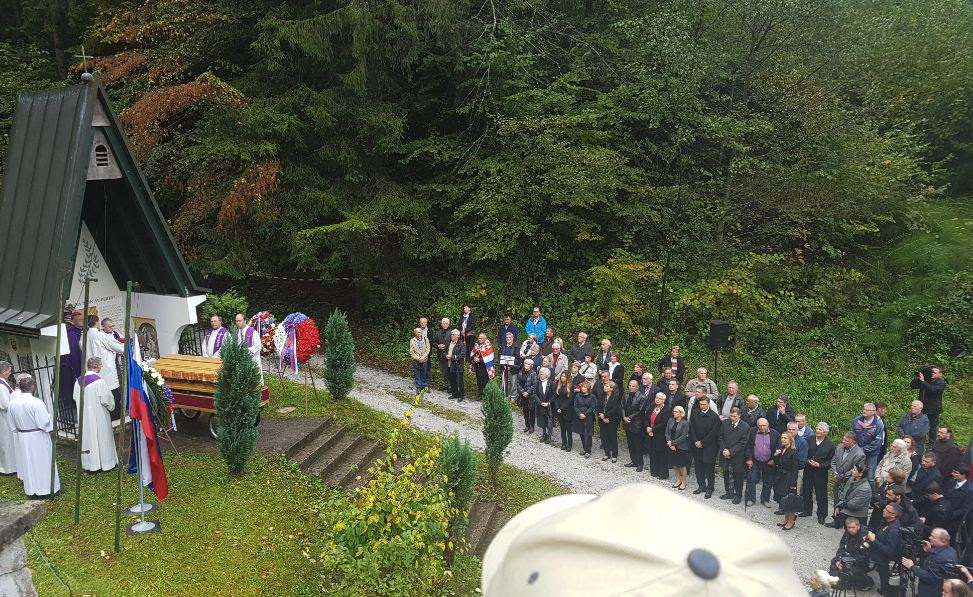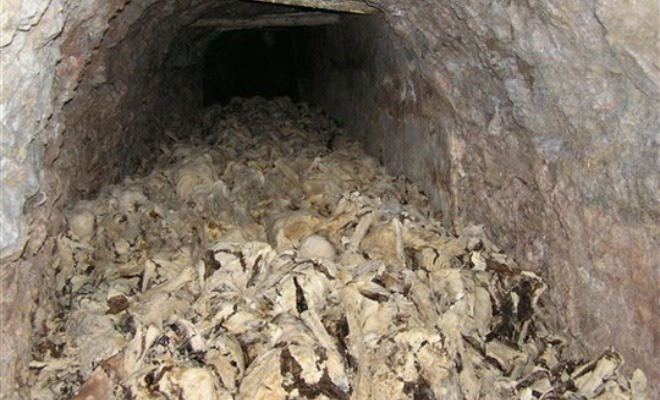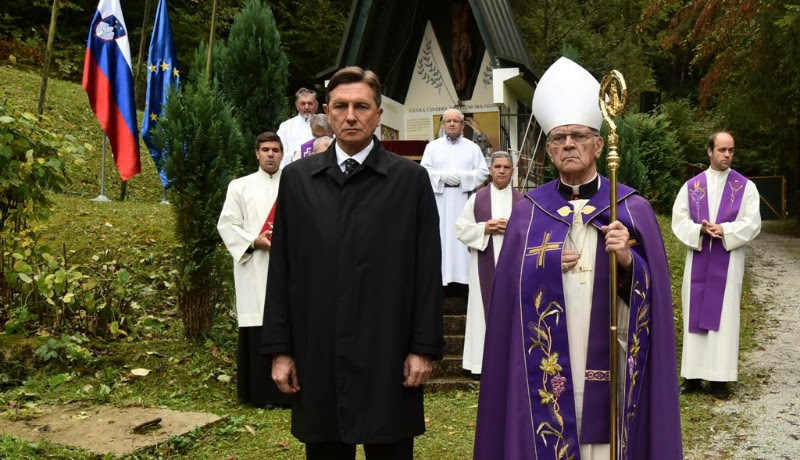
Huda Pit
Communist Crimes mass grave
Transfer of victims' remains ceremony
Photo source: dnevno.hr
It was May, 1945. The Second World War was over, and the real agony of civilian refugees and defeated soldiers (independence and freedom from Kingdom of Yugoslavia fighters in particular) from the territories of former Yugoslavia had just begun. The agony of the defeated Croatian soldiers and civilians is known as the Way of the Cross. Instead of the humanitarian protection they should have received, Yugoslav partisans, communists, gave them death sentences. Endless columns of refugees from Yugoslavia walked towards the West, seeking refuge and instead were sent back and sent on the road of no return – Huda Pit was one of the places where that road finished for thousands innocent victims. Post WWII Communist Yugoslavia was literally littered with mass graves, particularly Croatia and Slovenia – the remains cluttered the underground in deafening silence for decades as Yugoslavia’s communists kept a tight lid over the mass graves and their depraved crime sprees, filled with hatred for and revenge against anyone disagreeing with communism or actively seeking freedom and independence. Up till now some 624 mass graves of communist crimes have been discovered in Slovenia with multitudes of thousands of tortured and slaughtered Croats, not only POW soldiers, but also old men and women, women with children.It was in 2009 when the authorities first opened the Huda Jama (Pit) mine, some 80 Km northeast of Ljubljana, one of several hundreds of mass graves dotted around the former Yugoslavia filled with remains of victims of communist crimes, mass slaughter. ‘It is one of the most shocking things you could see in your life,’ said at the time Barbara Brezigar, Slovenian State Prosecutor, reacting to the terrible sight she had seen of the victims’ remains.

Inside Huda Pit mass grave (photo taken 2009)
Huda Pit is believed to be one of the largest multiple mass graves of members of defeated armies and civilians killed towards the end of WWII by Communist authorities and intelligence services. There are sealed-off disused mine shafts within the old mine forming mass graves experts believe could contain over several thousands of victims, Slovenians and mainly Croats, women and children among them.

Many gathered at Huda Pit
on 3 October 2016 to witness
the transferal from mass grave of remains
of victims of communist crimes of former Yugoslavia
Photo: dnevno.hr
Transferal of the remains of the first 800 victims unearthed to a memorial centre at Dobrava, west of Ljubljana, had begun on Monday 3 October 2016. Bishop Stanislav Lipovsek of Celje, Slovenia, led the funeral and carrying-of-remains ceremony in the presence of the Slovenian president Barut Pahor and hundreds of people many of whom are still wondering whether the remains of their parent, grandparent, brother, sister … were among those carried out from this pit on Monday – all they know is that communists slaughtered and buried them, somewhere in the area. The transfer of the victims’ remains is likely to be completed by 27 October when Slovenian President Borut Pahor is due to attend a commemoration at the Maribor cemetery. The burial of remains at Dobrava (Tezno) will enable later burials into individual family graves once identification of the victims is completed; there will also be a common graveyard prepared for some of these victims whose identity may not be confirmed. Communist crimes’ apologists will go on telling the world that all these people deserved to die because they were Nazi-collaborators. They will not tell the world that these people were executed without a trial, without a shred of evidence against them when it comes to Nazi-collaboration. The slaughter was a part of a political agenda where communism had to clear the way – without significant opposition to it – for its rule and regime in Yugoslavia. Communists acted as judge, jury and executioner to those with differing political views.

Slovenian President Borut Pahor
with Bishop Stanislav Lipovsek
at Huda Pit Monday 3 October 2016
Photo: STA
President Borut Pahor has stated on Monday that the reconciliation of the formerly opposed sides and coming to terms with the past is a continuous process, and that the act of reburial could be a historic turning point. “Reconciliation is possible only once we are ready to forgive and to admit the truth even if it is painful, hard and incriminating,” Pahor said during the ceremony, attended by victims’ relatives. President Pahor gave an exclusive statement to the “Bujica” TV program team at the Huda Pit site on Monday: “This was necessary to do in order to deal with the past and for a better understanding of the future. I know that there are those who will say that it is more important to solve the current problems and that the history cannot assist with this, but I do not think like that! The fact that we have today begun solving one of the most dramatic events in our history from the middle of the last century, can also help the future of our nations. The job is not done yet. I wish that in the near future we will able to say that all our dead are buried in peace, and that our children and grandchildren will only then be able to devote themselves to other problems. At the last informal meeting I had with your President, Mrs. Grabar - Kitarovic, we talked about Huda Pit and all the other places where the victims require a dignified burial and reverence paid, piety shown for the deceased who were killed without trial, after the Second World War in Slovenia. We agreed that we need as two of the Presidents, act in such a way that will send a message of reconciliation regardless of the past the future peace. This will be done during coming months.”

Bishop Lipovsek blessing the caskets with victims' remains
Monday 3 October 2016 Huda Pit Slovenia
Photo: STA
There is reported evidence that some of the victims were buried alive to die in agony. Nothing, nothing justifies or lessens these crimes and it is an appalling state of affairs to have seen that no Croatian government or presidential representatives took the effort of being at Huda Pit on Monday. No excuses possible there as far as I am concerned, not even the fact that the new government has not been formed yet. Surely, the fact that to date there are over 900 locations of either mass or individual graves of victims of communist crimes in Croatia (let alone Slovenia and the other states of former Yugoslavia) where Croatian victims are buried is motive and justification enough to dedicate a whole government department to deal with this terrible injustice towards innocent people in Croatia – not just an office. This is the part of Croatian history that has not yet been dealt with properly and it must. Slovenian president Pahor just stated at Huda Pit on Monday that which has often been said in my articles and that is a good sign for justice to come. Ina Vukic, Prof. (Zgb); B.A., M.A.Ps. (Syd)
Nema komentara:
Objavi komentar